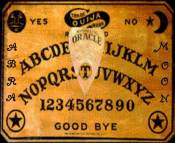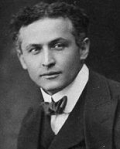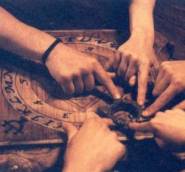
Ouija
Do you believe Ouija boards are evil? Should they be banned from the general public? A history and belief have been told about them for generations. But there’s one problem – it’s a toy, made from cardboard and plastic. It is mass produced by Parker Brothers, the same people that makes Clue and Monopoly. Parker Bros. is a corporation like any other and have no discernable evil intentions. So why is there such a controversy about them in the paranormal and spiritual fields?
Let’s look back into the proposed history of the Ouija board. One belief that is said to be the forerunner to the Ouija board is Fuji. Fuji is the divination method in which Chinese characters are drawn in sand or incense ashes. But this is not Ouija, this is a form of spirit writing, with no board. Not Ouija. Another proposed precursor is, according to a Greek historical account of the philosopher Pythagoras, in 540 B.C. his group would conduct séances at “a mystic table, moving on wheels, moved towards signs, which the philosopher and his pupil, Philolaus, interpreted to the audience as being revelations supposedly from an unseen world.” The only problem is that there is no record of Pythagoras or his students actually performing this method, and Philolaus was never a pupil of Pythagoras and was in fact born roughly 25 years after his death.

Ouija Board
In fact, the earliest form of the modern interpretation of the Ouija board can only be found in the late 1800′s, during the heyday of the Spiritual movement. During that time, planchette’s were widely sold as a novelty in which a pencil was usually attached, writing letters or other designs on paper to be later interpreted by a medium, for a decent pay of course. On May 28th, 1890, businessman, lawyer and inventor, Elija Bond filed for a patent for the first planchette sold with a board on which the alphabet was printed, simply calling it the Talking Board. In 1901, William Fuld, an employee at Kennerd, took over the talking board production, calling it the “Ouija Board” for the first time. After his death, Fuld’s estate sold the entire business to Parker Brothers. So, it is not an ancient invention.
As mentioned earlier, the Ouija board was created during the heyday of the Spiritualist movement, let’s look at this. Spiritualism is a belief system that lasted from the 1840s to the 1920s with as many as eight million followers in the United States and Europe in 1897. Spiritualists believe in communicating with the spirits of the deceased. They believe that spirits are capable of growth and perfection, progressing through higher spheres or planes. They claim that spirit mediums are gifted people who can communicate with the dead and provide knowledge about moral and ethical issues, as well as about God and the afterlife.

Harry Houdini
One of the most well known aspects of this time is the vast number of fraudulent mediums. One of the most well known skeptics of the psychics and mediums of the day was Harry Houdini. His training in magic allowed him to expose frauds who had successfully fooled many scientists and academics. He offered a cash prize to any medium who could successfully demonstrate supernatural abilities. None were able to do so. This search for the truth ended his long time friendship with Sherlock Holmes creator Sir Arthur Conan Doyle, who was a firm believer in Spiritualism. His final opinion on the matter was “Up to the present time everything that I have investigated has been the result of deluded brains.” the time, purpose, and circumstances of the Ouija boards creation were extremely dubious.

Using the Ouija Board
Now on to the act of the Ouija board itself. One very easy explanation is that a fully conscious person is controlling it under their own power. If you really think about it, this is extremely plausible since it is mostly considered a toy by the general public. Another explanation is a subconscious behavior called the Ideomotor Effect. The Ideomotor Effect is a phenomenon where someone makes motions unconsciously. Harvard physician-turned-psychologist William James describes it as “Wherever a movement unhesitatingly and immediately follows upon the idea of it, we have ideomotor action. We are then aware of nothing between the conception and the execution. All sorts of neuromuscular responses come between, of course, but we know absolutely nothing of them. We think the act, and it is done; and that is all that introspection tells us of the matter.” The same article that this quote is from goes on to say “Modern brain researchers have produced data and theory that help explain how quasi-independent modules in the brain can initiate motor movements without necessarily engaging the “executive module” that is responsible for our sense of self-awareness and volition.”
With that in mind, I’d like to tell you a fascinating, true, story. In late 1972, an experiment was conducted by the Toronto Society for Psychical Research. They wanted to see if they could create a ghost. They assembled a group of eight people, known as the Owen group, named after it’s originator Dr. A.R.G. Owen. It consisted of Dr. Owen’s wife, a woman who was the former chairperson of MENSA, an industrial designer, an accountant, a housewife, a bookkeeper and a sociology student. The group was tasked with creating a fictional character. Together, they created a name and complete background to the character “Philip Aylesford”.
Their detailed biography of “Philip” is as follows.
“Philip was an aristocratic Englishman, living in the middle 1600s at the time of Oliver Cromwell. He had been a supporter of the King, and was a Catholic. He was married to a beautiful but cold and frigid wife, Dorothea, the daughter of a neighboring nobleman.
One day when out riding on the boundaries of his estates Philip came across a gypsy encampment and saw there a beautiful dark-eyed girl raven-haired gypsy girl, Margo, and fell instantly in love with her. He brought her back secretly to live in the gatehouse, near the stables of Diddington Manor – his family home.
For some time he kept his love-nest secret, but eventually Dorothea, realizing he was keeping someone else there, found Margo, and accused her of witchcraft and stealing her husband. Philip was too scared of losing his reputation and his possessions to protest at the trial of Margo, and she was convicted of witchcraft and burned at the stake.
Philip was subsequently stricken with remorse that he had not tried to defend Margo and used to pace the battlements of Diddington in despair. Finally, one morning his body was found at the bottom of the battlements, whence he had cast himself in a fit of agony and remorse.”
They even went so far as to enlist an artist to sketch a portrait of him.
They would then have informal meetings to discuss Philip and his life, and meditate. This went on for a year with no results. Changing course, they decided to change the decor to be more like the atmosphere of a classic spiritualist séance. This change seemed to work because they soon after received “communication” from Philip. Starting with rapping on the walls and even going as far to have lights flicker and tables levitating. It was so successful that they decided to try it again with a completely different group of people and a new fictional character. They soon got the same results and the same happened for an Australian group as well. Mind you, these “ghosts” were completely fictional, created in the participants minds.
Looking back, the history of the Ouija board is very recent and has strong connections to questionable beliefs, it was created as toys and novelty items, that along with the strong evidence toward it being a subconscious act, it is extremely questionable that it is actually supernatural. The definition for Supernatural is “of, pertaining to, or being above or beyond what is natural; unexplainable by natural law or phenomena; abnormal.” So, basically, even if there’s a small chance that it can be explained as a normal and misunderstood object, chances are that it’s not supernatural at all.
Even if you still believe that it’s powers are true, you should know that most Spiritualist believe it to be just a tool that brings the ghosts or demons into this world. In other words, you channel your beliefs through it. It is an object that keeps you concentrated on the thought of spirits. So, technically, anything, be it a drinking glass, flashlight, spoon or car keys, can conjure spirits as long as you concentrate enough on it.
So, in conclusion, it is just a mass produced collection of cardboard and plastic. It’s what you do with it that matters.
Written by “Bracket”, Copyright 2009 TrueGhostTales.com
More about “Philip” www.themystica.com/mystica/articles/p/philip.html












![The Chronicles of Narnia: The Voyage of the Dawn Treader [Blu-ray] Image of The Chronicles of Narnia: The Voyage of the Dawn Treader [Blu-ray]](http://ecx.images-amazon.com/images/I/61419vkvboL._SL110_.jpg)

